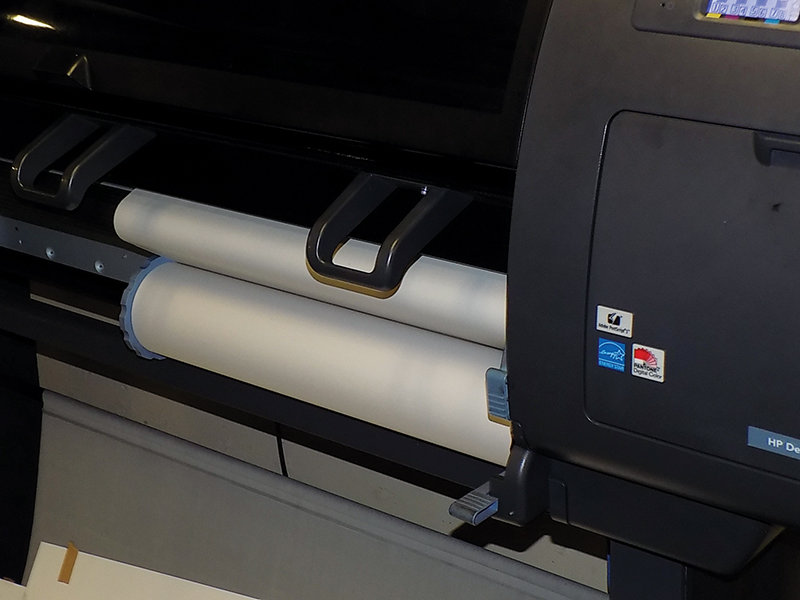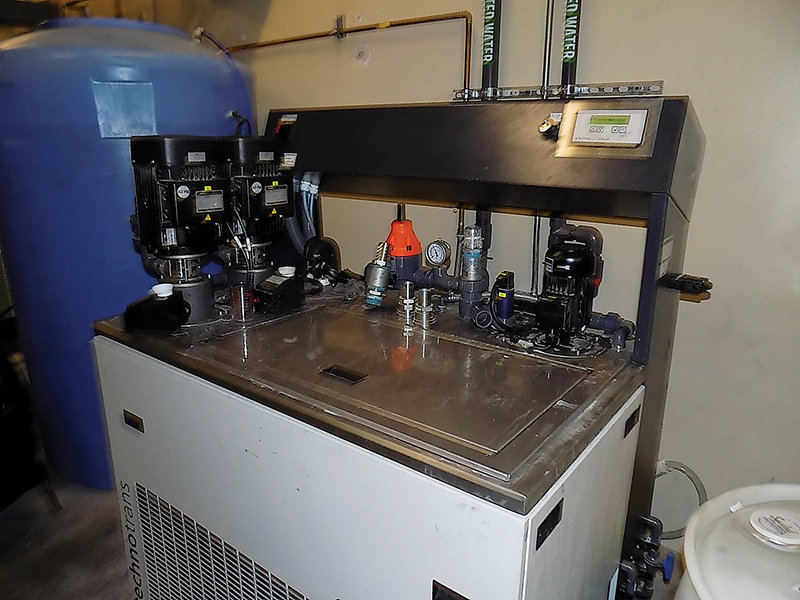 Instead of labor intensive and inaccurate color keys, plotters can produce color matches in a fraction of time on newsprint stock.
Instead of labor intensive and inaccurate color keys, plotters can produce color matches in a fraction of time on newsprint stock.
I’ve been in newspapers and printing a long time, so when it came to writing an article about innovation and upcoming trends in our industry I thought “No problem. This should be a breeze.” Much to my surprise, I found myself frustrated, even dare I say angry, at so-called innovation in our industry in the past few years. Pretty strong emotions for someone who keeps defending the print industry and truly believes in the value of the printed word.
Here’s what brought me to this point. When I started looking at current innovations and trends in our industry, I began searching my mind for material. After coming up short, I figured I’d give the internet a shot to get the creative juices working. I googled “innovations in the newspaper industry.” The most interesting thing I got back was an explanation of Gutenberg’s wonderful invention, the printing press.
At this point, some frustration set in.
That same afternoon, a vendor stopped by and I figured I’d bounce my innovation question off him—nothing. That’s when anger set in at our industry. This industry that I love and enjoy every day, that has provided a wonderful living for me for many years, was now coming up flat.
I thought back to when innovation was running wild in the industry and it brought back pleasant thoughts, but made me realize all the more how much we’ve been resting on our laurels over the past few years when it comes to printing. We fear the internet and digital news is going to run print out of business, yet I couldn’t find a thing to boast about how “innovative” we’re becoming.
Strangely enough it reminded me of the Mike Tyson/Buster Douglas fight. What does this have to do with newspapers?
I grew up in upstate New York about a mile from Mike Tyson, Cus D’Amato and yes, the infamous pigeons. At the time I had hope in the hometown guy, similar to how I felt about printing. Tyson went into the fight a shoo-in; Buster Douglas was a 42-1 underdog. Like print, Tyson couldn’t be stopped. He’d been around for awhile and in his career, he walked through anyone who got in his way. He was the big guy on the block that no one could stop; he owned his industry. Sort of like the printed version of our newspaper. Douglas was the internet—not a big threat, something that at the time we couldn’t regard a serious threat.
One of these fighters had heart, determination and desire; the other fully expected to do what he had done all along and didn’t prepare, didn’t have the heart and surely didn’t innovate. We all know how that ended.
Hopefully you’ve drawn the parallel now back to print. The threat of the internet was greatly underestimated by many and now we’re paying the price for our ignorance.
The fear for the print media started in the 1940s. For many publishers, the arrival of radio and television spelled the demise of the print industry. When television journalism began to grow, so did the decline of print readership, but it was nothing compared to the last few years.
In newspapers, the majority of our revenue has always come from print. Now, as a result of the decline in readership, the revenue model has flipped over to the majority of our revenue coming from circulation. I’m not quite sure how long we can sustain this model if we don’t do something to show our superiority over news on the internet (hint: more hyperlocal coverage).
We need innovation to move things forward in newspapers immediately, so let’s take a look at some of those production trends that could affect which direction we take.
New Trends in Ownership
Say what you will about some of the new owners in our industry. I’d agree that the cost reductions have been painful and we’ve all been affected by them in one way or another. But these cost reductions and new “innovative” methods of management have also saved many newspapers from extinction.
Newspapers need to be profitable to succeed and this takes money from innovative management, innovative new ideas and innovative owners. The same old/same old will just contribute to the continuous backslide of print.
I believe the trend we’ve seen by hedge funds and billionaires to buy print newspapers throughout the industry will continue to expand in years to come.
Consolidation of Printing Sites
This has saved more newspapers than anything else I can think of over the past few years. As everyone knows, press and production operations are expensive to operate. When we were enjoying 40 or 50 percent margins, you could exist on printing a 10,000 circulation daily paper and still remain very profitable.
As new ownership (in most cases group ownership) purchased smaller newspapers, the trend of consolidating printing to one common site has taken on a life of its own, for the right reasons.
I hate that this has cost us jobs at individual small papers in the production departments, but this trend has saved several newspaper operations and therefore saved jobs in other departments outside of production, and continued to provide local news for many in small rural areas.
 Technology to maintain fountain solutions on offset presses has come a long way in a short period of time.
Technology to maintain fountain solutions on offset presses has come a long way in a short period of time.
Commercial Print Operations
Not to be confused with consolidation, commercial print will continue to thrive in well run shops throughout the industry.
The days are over when our industry enjoyed enormous profits, printed just our daily paper and actually told advertisers if they didn’t hit the deadline their ad wouldn’t run (I have to admit I miss those days).
Today we need to simply manage more innovatively, and one way to do that is to fill our press downtime with profitable work in the form of outside printing.
Those smaller shops that no longer can afford to print just their own daily, or the shops whose press is wearing out and now costs them more to keep running than it’s worth, are turning to outside printers to stay afloat. This process is a win/win for most print sites that have stayed current and have open print windows and the talent to take on additional publications from outside.
Commercial printing will continue to be a strong trend for smaller properties to move to and larger properties to profit from in years to come.
Production Technology
The recent shortage of new innovative technology in the printing industry was what started me on the early tirade in this article. Now I’ll try to put a positive spin on things, but I’ll warn you that while I’m overjoyed to write on where we’ve come in the last 20 years, I’m still none too pleased on where we seem to be going now.
Prepress: When I got into the printing business many years ago, all the “old guys” were still reminiscing about the days of hot metal and how this new trend of cold type was nothing but the devil’s doing.
I spent the early part of my career trimming single galleys of type with a pair of scissors and running them through a waxer before carefully placing them on the gridsheet strip by strip. Then innovation arrived (or so I thought at the time). It was wonderful when someone made it possible to put multiple columns of type on a wide galley of photosensitive paper and saved me a whole lot of trimming, but that was just scratching the surface of what was to come.
Cutting to the chase, prepress technology soon became totally computerized and pagination was born. In a very short span of time, we went from the point of millions of dollars in front-end equipment to desktop publishing.
New publications were popping up all over the place. Anyone with some journalistic ability and a few dollars to purchase a computer and the necessary software package could now be a newspaper publisher. Granted this has some shortcomings, but overall it was good for our industry. Most of all, it was innovation we all could be proud to be a part of.
Platemaking: Second only to improvements in prepress technology, this may be the most innovative and advanced area of newspaper printing.
When I first started in the business, I remember my plateroom running bare medal (aluminum) plates through a coater to put a protective finish on them. It was a messy process. If you didn’t get an even roller pressure, it would result in an uneven coating and spell troubles on press; if you touched the plates before they were dry, you’d leave fingerprints; and at best, it was a slow process. Adding to the fun, this all had to be done in a dimly lit, yellow light environment.
Afterward, you’d “burn” the image from a negative to the plate. You’d have to be sure the negative vacuum was good and the negative drew down onto the plate evenly across. A little bit off on the exposure and you’d have a mess; either it wouldn’t last for the whole pressrun or you’d plug the images.
I won’t even go into what it took to produce a negative before the plating process outside of saying it had its challenges.
Fast forward through the years, we now have CTP (Computer to Plate) technology in just about every shop, large and small. We’re able to send a file (normally as a 1-bit tiff) to the equivalent of a big “printer” and reproduce that image onto a pre-coated plate in a fraction of the time it used to take with precise quality and sharpness. These plates are now bent to a precise fit and alignment with a vision bender verses the old manual bending process that was at best highly inaccurate.
 This old punch is far from the vision benders we have today. Innovation has been strong in this area and advanced in the platerooms of today’s newspapers.
This old punch is far from the vision benders we have today. Innovation has been strong in this area and advanced in the platerooms of today’s newspapers.
Color keys: When it came time to proof an ad or color photo, we took a thin piece of plastic called a 3M color key and developed each color (CMYK) and hung them up to dry, placed them together to hopefully replicate what the final color photo should look like, and sent it to the press.
Today we output a PDF to the plotter and minutes later have an accurate color proof on newsprint to help the press match color. Now, that’s innovation.
Presses: As an industry, we’ve been through lithographic printing, traditional offset, flexographic printing, and for awhile, I thought we’d be off and running with digital printing. I’ll probably catch a lot of flak for this but I’m still not convinced the economies exist to make digital printing our next trend.
Digital presses lend themselves to short runs and due to low/or no waste and minimal manning are very formidable opponents for our conventional offset printing process. But when we get into larger pressruns, I just don’t see the financials working. That’s all I’ll say—that and “I’ve certainly been wrong before.”
When I got into the printing industry, all operations were manual. We set ink by hand with keys. Granted many presses still are manual, but look at the innovation in presets and inking systems. Automation is a wonderful thing.
For water systems, the normal choices were socks or brush dampeners; then along came spray bars, which was a welcome innovation. From the days of cleaning out brush rollers with a wire brush or replacing a blown sock in the middle of a run, we can now set pulse rates and spray patterns with a maraud of control settings at our fingertips.
Inline web systems now control color registration with small high-speed cameras running across the web and sending data back to a computer that then adjusts accordingly to ensure registration. This is a huge improvement from the days of running up and down ladders to move comps and/or shutting down and shimming plates.
Inserting operations: Many of our newspapers couldn’t afford high-end inserting equipment. If you’ve worked in newspapers for any length of time, you’ve no doubt hand-inserted papers. My first automated inserter experience was on a small Kirk-Rudy. OSHA may not have been as serious about guards back then and often it looked more like a war zone than a mailroom.
Anyway, it was quite an advance from hand-inserting. Over the years equipment has become faster, more reliable, and now we’re able to program multiple zones, spit out productivity reports on pieces per hour, doubles, misses, etc.
We’ve come a long way with inserting equipment, and the innovations here have been nothing short of wonderful.
 Huge banks of electronic/digital drives have made offset printing more reliable and show a distinct advantage of older analog drive systems.
Huge banks of electronic/digital drives have made offset printing more reliable and show a distinct advantage of older analog drive systems.
More Innovation is Still Needed
To borrow from my earlier boxing metaphor, print is in the tenth round and on the canvas frantically reaching for its mouthpiece. Unless we in production—with the help of some bright individuals much smarter than me—find new and innovative ways to continue the trends that have brought the printing processes and production in general ahead, we’re simply going to be swallowed up by the internet. We need to put processes together and develop technology to more efficiently and cost effectively produce better quality with less labor cost and more predictability.
So now that I’ve gone though some of our trends, triumphs and innovations of the past, I will return to my original thought and ask you, “What innovations have you seen in the last few years in printing?”
 Jerry Simpkins is vice president of the West Texas Printing Center, LLC in Lubbock, Texas. Contact him on LinkedIn.com or at simpkins@tds.net.
Jerry Simpkins is vice president of the West Texas Printing Center, LLC in Lubbock, Texas. Contact him on LinkedIn.com or at simpkins@tds.net.
Comments
No comments on this item Please log in to comment by clicking here